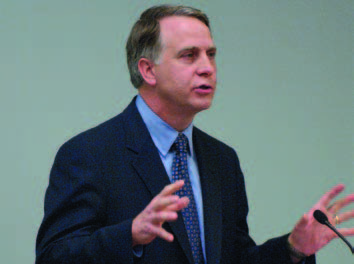Excerpted from the talk “Inquiry-Driven Engineering: One of the Liberal Arts,” given by James Wagner at the Harriet Shriver Rogers Lecture on April 30, 2007, at Johns Hopkins. Wagner, MS ’78, PhD ’85, is a former Whiting School faculty member and department chair and today president of Emory University.

Engineering disciplines, particularly inquirydriven disciplines, deserve to be counted among the liberal arts.
When focused too narrowly on the professional nature of our discipline, we as engineers often exclude ourselves from thought and discussion about those matters that address why we live, not merely how we live. Understanding engineering as a “liberal art” opens rewarding possibilities for contemplation and contribution even to those of us whose linear and quantitative minds might at first glance appear unsuited for such pursuits.
Let’s remind ourselves first what liberal learning is all about. Historical accounts probably go back to Cicero’s time in the first century B.C. It was a time when the aristocracy had leisure to consider cultivating a life of the mind— when attention to matters of survival could, for some, take a back seat to matters cerebral. And so there arose education “appropriate for free men,” as opposed to education in the servile arts.
Liberal education had (and still has) only two primary purposes. First, liberal education is intended as a means for the student to identify and hone a personal learning style. We as engineers tend, most often, to be linear and logical thinkers. Humanists tend more often than not to follow more parallel paths of thinking to form opinions and express thoughts. To help learners identify their learning style, several disciplines became identified as fundamental and were grouped in the Trivium and the Quadrivium.
The Trivium consisted of grammar, dialectic (logic and reasoning), and rhetoric, while the Quadrivium encompassed arithmetic, music, geometry, and astronomy. Only later did the curriculum grow to include history, art, literature, mathematics, the social sciences, physics, chemistry, and biology.
“Engineering education, too, needs to continue to move beyond the old ‘training’ mode—the stereotype of producing engineers who are merely ‘problem solvers.’ This definition is too narrow, too passive, and too Dilbert-like.” James Wagner
When students, through exposure and attempted mastery of these early disciplines, developed an understanding and command of their own learning style, they were only half educated. Because, you see, the second purpose of liberal learning was, and still is, to instill an insatiable thirst for more knowledge, slaking that thirst by means of the learning style that best suits you.
I don’t believe that the explanation for engineering’s exclusion from the Trivium and Quadrivium lies in antiquity, however. I imagine, rather, that if academic engineering as we know it had been around in Cicero’s time, it would have been included.
Early on, the French were the most progressive adopters of engineering education for civilians. In 1747, they established the first of many Ecoles Nationales (National Universities), with the first one focused on bridges and highways. Soon the Germans and the Russians followed suit. And for nearly a century, these continental European institutes were nearly alone in their pursuits. However, during the Alumni and Leadership making an impact same period, the British pursued and perpetuated the classical liberal arts education. They agreed with Plato that the “mechanics arts were not a fit occupation for the educated citizen.”
In the United States, the first colleges and universities were established on Britain’s models of Oxford and Cambridge and thus became similarly bound to a classical definition of university education. Only in the United States Military Academy at West Point, established in 1802, was engineering taught—military engineering, of course. American universities resisted the demand to educate engineers and scientists.
At the 1876 National Centennial Celebration in Philadelphia, Daniel Coit Gilman, one of the judges of the expositions, was impressed by, and wrote effusively about, the exhibition by two Russian science and engineering academies. Gilman, of course, guided Johns Hopkins to break from the classical tradition of education that had been championed by British institutions, moving toward a more European, continental model of graduate education broadly, and of graduate education in the sciences in particular.
The goal must be not merely training professionals but educating people (scholarcitizens) who pursue a profession. And, engineering education, too, needs to continue to move beyond the old “training” mode—the stereotype of producing engineers who are merely “problem solvers.” This definition is too narrow, too passive, and too Dilbert-like. Increasingly, engineers are like our liberally educated colleagues—prepared to be engaged citizens so that they are, first, problem and opportunity identifiers, then translators of problems into engineering terms, and, finally, problem solvers. Johns Hopkins University and its Whiting School of Engineering are places that seek not simply to train professionals but to educate, to develop scholar-citizens who pursue professional service. Hopkins does now and must continue to lead by example.




